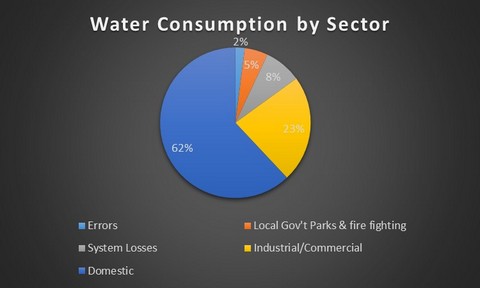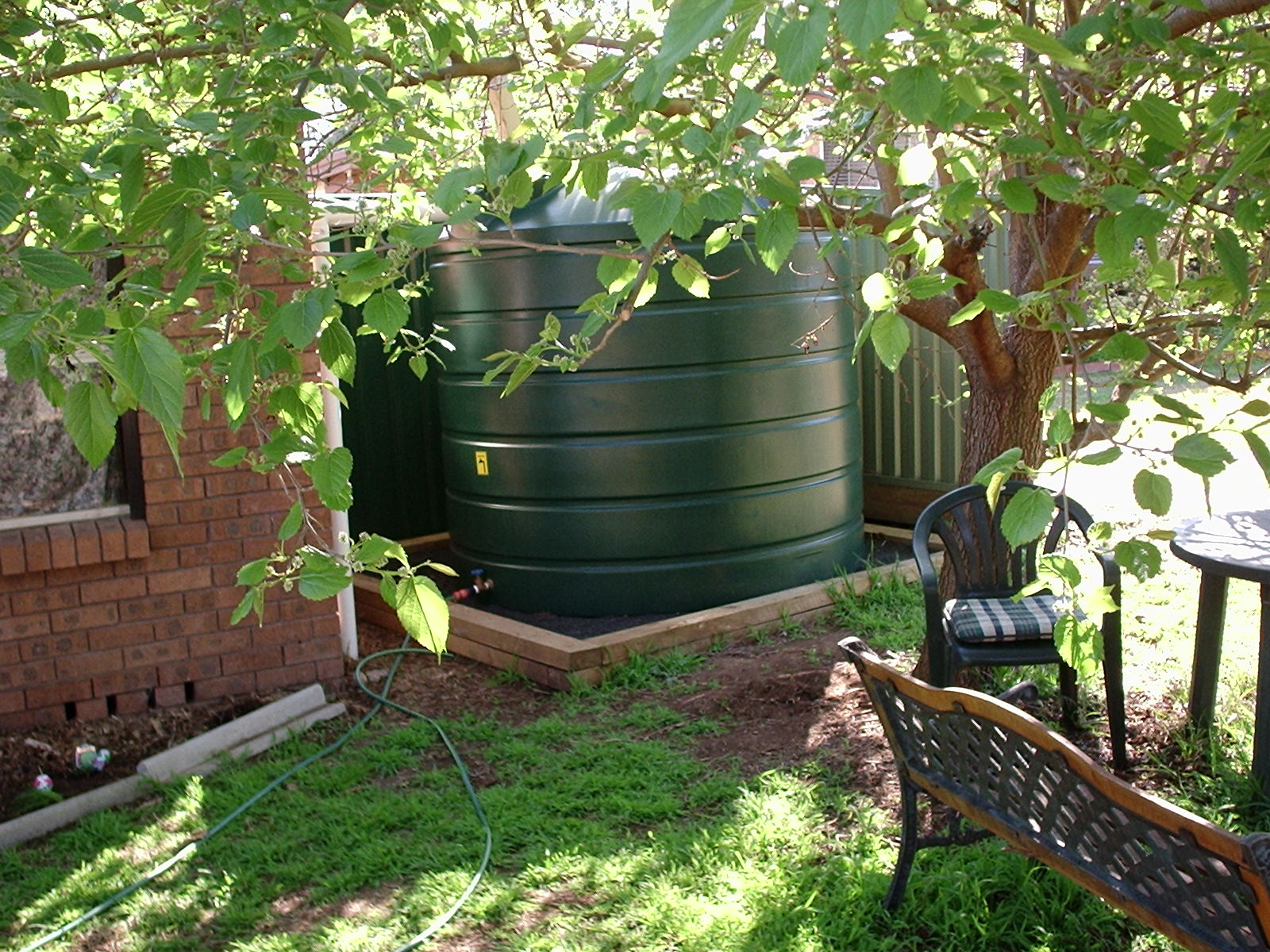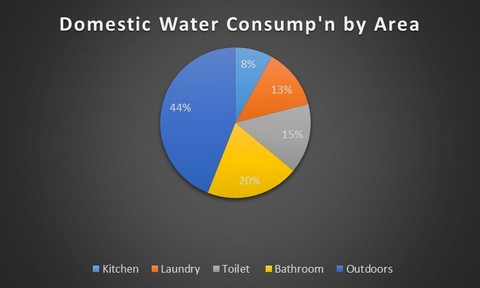Australia is a drought country and if the predictions of what is going to happen due to climate change are true, the position is likely to become worse rather than better. Australian households consume roughly 60% of the water captured, purified and then pumped to our cities us as part of our reticulated water system (See graph below). The average Australian uses 180 to 200 litres of water per day directly and this water is provided at an energy cost of 164 kilowatthours per person per year in Australia.

This energy use is usually not factored in when doing calculations on how much energy is consumed by a household because it is consumed indirectly and we think in terms of buying and consuming water rather than energy. As a result of the energy use, the provision of water contributes roughly 160 kilograms of CO2 per person per year here in New South Wales because our electricity is mostly generated by black coal (anthracite) powered power stations. In Victoria this figure is closer to 200 kilograms of CO2 per person per year due to the use of “dirtier” brown coal (lignite) for power generation.
Taking into account all this information it is easy to see that by reducing the amount of water we draw from the reticulated water supply, we are not only saving the water itself and thereby saving money we are also saving energy and thereby carbon dioxide emissions as well. Hopefully I have convinced you that saving water is a good thing!
Three Options
In general terms once we make the decision to reduce our water consumption there are three broad techniques for achieving our aims –
- Store and use rainwater – By investing in rainwater tanks attached to any or all of the household buildings we can start to harvest what is essentially a free resource – rainwater. The rainwater can then be used in place of the reticulated water supply wherever you can manage it as it is energy and therefore carbon free.
- Re-use Greywater – Greywater is water that has been used once and would normally be disposed of to a sewer system and lost to the household. This greywater can be made to do more work and fulfil duties that would normally be expected of fresh, reticulated water such as flushing toilets or watering lawns and trees. Greywater can be given a decontamination process before it is used or used as is, but should not be stored due to bacterial contamination. The water from a flushed toilet is referred to as black water and should not be re-used on site, water from the kitchen sink may be too heavily contaminated by fats, oils and detergents and likewise should not be re-used.
- Reduce Demand – I’ll bet that the title of this article has given the game away and you are able to guess that it is this third one of the three options which we will be focussing on!

Having said that, this is not an “either/or” process and ideally you will want to implement techniques from all three of the above options to reduce you consumption of water from the reticulated supply.
Where do we Start?
The great quality management guru W. Edwards Deming said it best in the saying attributed to him –“that which you don’t measure, you don’t control”. In other words, get some data which tells you where you are using the most water so you can hit those areas first. Fortunately there is a readily available process to help you work out where your water consumption is going – The Water Audit.
While there is a detailed description of how a water audit is conducted here, the general process is summarised in the steps below -
Identify household water uses
- Record over a week the amount of water you use
- Validate your workings against records (water bills)
- Identify any leaks
- Work out potential rain harvest
- Work out how much greywater is available
- Work out how much tank capacity you need
If you follow this process you will not only get an appreciation for where your greatest areas of water usage are, you will also have an idea of (potentially) the volumes of rainwater and greywater which you can use to further reduce your consumption.
Once your water audit is complete you will have the data you need to start planning how to reduce your water consumption. Below is a generic graph showing the percentages of water consumption in the “average” household, but real data on how much your household consumes will be more meaningful and useful.

Management Techniques
Following are some management techniques that will help you reduce the amount of water you need to run your household –
GENERAL
Think before you turn on a tap – This is about making sure that rather than reflexively turning on the tap to say, use perfectly drinkable water to wash the freshly cut grass off your paths, think about it first, and hopefully use a broom instead.
Investigate low water use appliances – low water use versions of washing machines, dishwashers and toilets are in existence and efficiency is improving year by year. I am not advocating running out and updating your functioning appliances right now but when replacement time comes around at the end of their life, a water efficient model is work checking out.
Insulate hot water pipes – I know this sounds like an energy saving modification (and it is) but it also saves water. Your hot water pipes will lose heat more slowly and you should not need to run through the cold water to get to hot so often or for so long. So you actually save water as well as energy. Winner!
Check for leaks, running taps & toilets etc. – as part of your water audit you should conduct a leak check (as discussed above). This is simple to do by turning off all taps for a couple of hours and then keeping an eye on your water meter to see if it moves. If it does move water is leaking somewhere. Sometimes a slow leak can develop between the toilet cistern and the pan. One way to check this is to put a bit of food colouring into the water in the cistern and if the colour appears in the water in the pan, you have a leak!
But this is not just about the water we are personally responsible for. How many times have you walked into a public toilet and found a tap you can’t turn off or (gentlemen) found a running cistern over a urinal. There are a number of public facilities that are maintained by commercial property owners or councils. if you see water being wasted in these facilities don’t just walk away let someone know there is a problem, even if it means you have to make a phone call. Water is a shared resource so let’s make sure we are not responsible for ignoring a leak.
Part 2 - Management tips and techniques applicable to each area of household water consumption
Part 3 - Embodied Water



